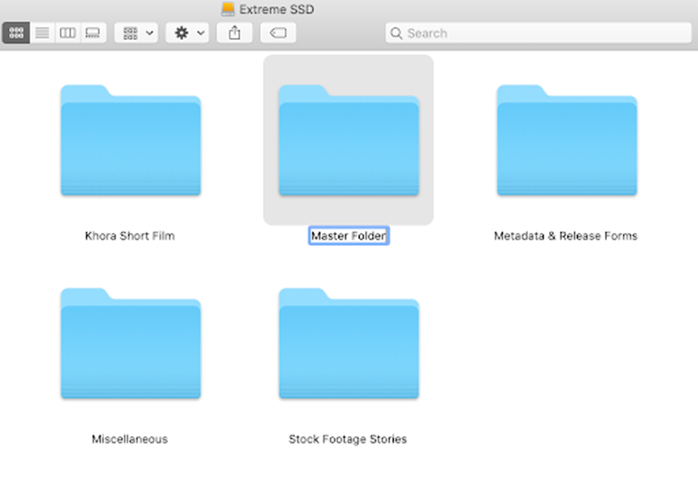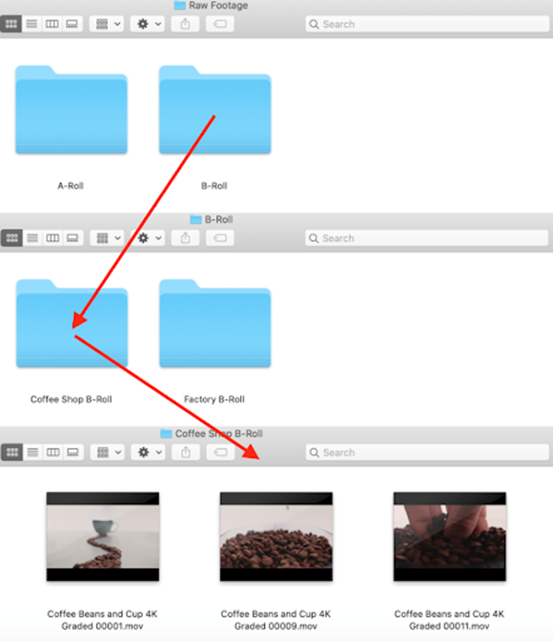What Is The Best Location To Put My Working Video Files Editing
Highlights
- Organizing digital assets, though often overlooked, is one of the biggest things an editor can practice to speed up a project and remove hurdles to creativity
- It helps protect against disastrous issues similar losing an edit
- Merely group together your files into labelled folders and put those into a principal folder for each project
As an editor, your ultimate goal is to creatively bring together visuals and audio to craft a final product that engages your audience. So why am I talking to you nigh organizing files? The fact is, while it probably isn't as fun equally editing, taking care of your digital assets (footage, music, SFX, etc.) is one of the all-time things you can practice to free upward your creativity and ensure a smooth editing workflow.
Why is it so important to organize avails before editing?
So you've been working on your edit all day, and yous're most done making a video - the cuts are working, the music is just right, and the color form is bringing your footage to life.
Just so disaster strikes.
You leave your edit for the night, and when you lot open information technology back upward, your screen reads "Media Not Found" or "Missing File" in big, scary text. Your timeline is all scarlet, and your clips are nowhere to be found. The reason? Y'all probably haven't organized your assets properly.

The experience above is something nearly every editor has gone through at some betoken in their career. Notwithstanding, the skilful news is it'southward completely avoidable. You'll find a step-by-step guide on how to organize your files below, but for at present, it basically involves group together all your assets into conspicuously-labeled folders and putting all of those into a master folder for your entire projection.
Organizing your assets allows your NLE system (Not-Linear Editing system, due east.thousand., Premiere Pro, DaVinci Resolve, Terminal Cut Pro 10) to locate the files you have decided to include in your edit. When you "bring in files" to an edit, you're not really moving anything (unlike what the phrase suggests). You are actually just telling your NLE system to look in the right folders and show you what it finds. And so when your files are well structured, it helps your plan detect what it needs, which, in turn, allows you to find your period.
More benefits of proficient file direction
So having professional file management will definitely help you avoid the ruby-red screen of doom, but in that location are lots of other great reasons to do it also. So before diving into a step-past-stride guide on organizing files for your next projection, here are 3 more big benefits of doing and then:
It helps you chop-chop locate avails while editing
Once you take organized your assets and opened upwards your NLE system, not only will your edit be secure, you lot'll also be able to find the files you lot want at breakneck speeds. Whatsoever you demand will already exist grouped into the intuitive folders you created, and so when it comes to finding a specific prune, song or sound effect, your editing software volition prove you where to look.
Information technology is vital for collaboration
Being organized is crucial when collaborating on an edit (e.g., sharing a timeline with a customer, getting feedback from a friend or showing a cut to your director). Unless you can re-create and hand over the same file structure you accept been editing with, your collaborator will likely take to manually link files themselves, which can be a nightmare, and on complex projects, it is nearly impossible. Just if y'all share your master folder, within which every asset is included in the edit, it should open up for them with no trouble.
It makes your project "mobile" and piece of cake to fill-in
Considering of the aforementioned principle discussed in the benefit above, with an organized file structure, your edit also becomes entirely transportable and a breeze to fill-in. As long equally your master folder is saved on a portable bulldoze (e.g., a hard drive or SSD), you can edit your projection wherever you are. For example, you lot could do it on your laptop while on a shoot, your home desktop reckoner or anywhere in between.
How to organize files for your next project - a stride-by-step guide
Now that yous know some of the biggest reasons to organize video files, it's fourth dimension to break downwards the (thankfully) uncomplicated procedure of doing so.
1. Create and name your "Principal Folder"

Your master folder is where you should store all the files you are thinking of including in your edit, and you should create this before you do anything else. While I have called mine "Master Folder," you should name yours after the project yous are editing so it'southward easy to find.
2. In the master folder, create relevant folders for all possible files

The idea hither is that you lot desire to be prepared for whatever possible kind of asset, so everything you may need in your edit has a identify in your file structure. Here'southward a cursory overview of these organizing folders:
- Project files - This is where you can save your projection/sequence files (the file your NLE system creates to tape your editing decisions)
- Raw Footage - Your main video folder (and possibly notwithstanding images, though you lot could create a carve up folder for these if y'all wish)
- Audio - Distinct from "Music/SFX," this would include dialogue, interview audio or voiceover
- Music/SFX - Music and sound effects to experiment with in your edit
- Graphics - Effects or graphics outside of your NLE system'southward congenital-in catalog
- Export - Finally, a video folder for your exported edits, which will prove helpful if you are creating multiple drafts
A helpful tip at this stage is to copy this master folder and save it in your bulldoze every bit a template, ready to exist populated for future projects.
3. Populate your folders with all relevant assets
Now that you have established a professional, secure file structure, information technology'southward time to fill information technology with all the digital assets you lot currently have to edit with. Then put your video clips into the "Raw Footage" folder, your audio recordings into the "Audio" folder, etc.
4. Use sub-folders to categorize avails further

While this may non be necessary for all video projects, creating even more folders within those listed in Pace two could assist you organize your assets farther. For instance, if you are editing a documentary, yous are likely to have both A-Roll (interviews) and B-Scroll (cutaways, stock footage). To help in the editing process, you could separate these into different folders within your "Raw Footage" folder. You could so divide those into further categories, such as by location or subject field. The end result should be a clearly divers file structure that leads y'all to exactly the asset you desire.
five. Open your NLE and import assets direct from your file structure
Depending on your chosen software, this procedure could await slightly different. However, so long as you import direct from your file structure, your edit should at to the lowest degree exist secure. In Premiere Pro, for case, you can click and drag your entire principal binder into the media browser, maintaining the structure y'all have designed. Terminal Cut Pro X, on the other hand, uses keyword collections to replicate file structures merely is otherwise a similar process.
So there you have it, a simple approach to professional file management. It will salvage your edit, speed up your turnaround, let your creativity run wild and go you on the way to condign a professional video editor.
Near Tim
Tim McGlinchey is a lecturer in Northern Ireland's leading film school, where he specializes in pedagogy cinematography, editing and scriptwriting. His professional background is in commercial videography and narrative filmmaking, which he still engages in heavily past writing and directing short films and contributing stock footage to Artgrid.io.
What Is The Best Location To Put My Working Video Files Editing,
Source: https://artgrid.io/insights/how-to-organize-your-video-files/
Posted by: mccoyleir1945.blogspot.com


0 Response to "What Is The Best Location To Put My Working Video Files Editing"
Post a Comment